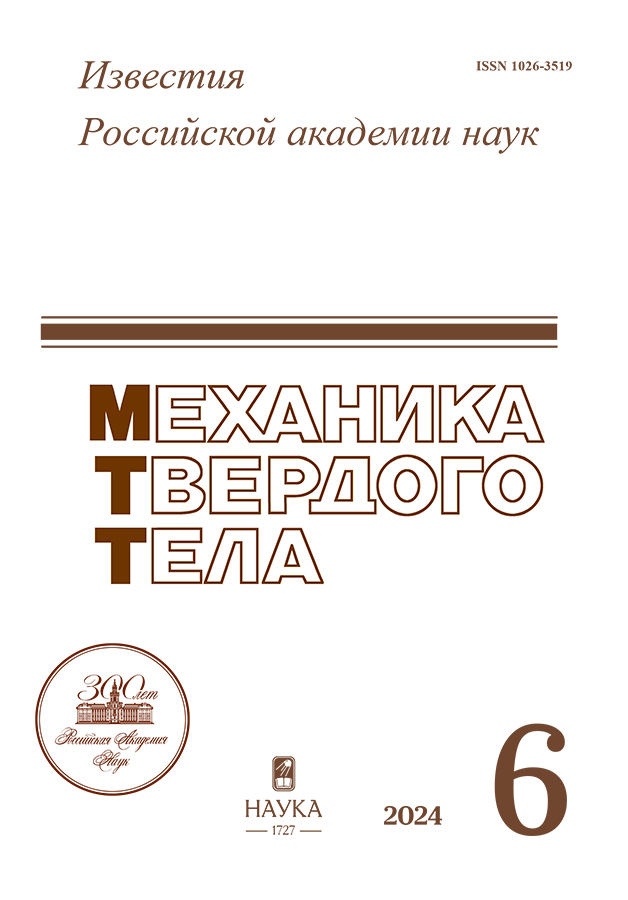Description of polymer gel properties in framework of generalized Mooney-Rivlin model
- Авторлар: Denisyuk Е.Y.1
-
Мекемелер:
- Institute of Continuous Media Mechanics of the Ural Branch of Russian Academy of Science
- Шығарылым: № 6 (2024)
- Беттер: 27-45
- Бөлім: Articles
- URL: https://ruspoj.com/1026-3519/article/view/682269
- DOI: https://doi.org/10.31857/S1026351924060023
- EDN: https://elibrary.ru/TZJMWT
- ID: 682269
Дәйексөз келтіру
Аннотация
. A polymer gel is considered as a mixture consisting of a highly elastic elastic material and a liquid (solvent) dissolved in it. Based on the generalized Mooney-Rivlin model, an expression of free energy is proposed that describes the deformation behavior and thermodynamic properties of polymer gels. In this model, it is assumed that the Mooney-Rivlin “constants” depend on the concentration of the liquid dissolved in the polymer. From this expression, the defining relations for the stress tensor, the chemical potential of the solvent and the osmotic stress tensor are obtained. On their basis, an experimental study of the deformation properties of mesh elastomers swollen in a solvent of various chemical nature has been performed. In particular, the dependence of the elastic properties of elastomers on the solvent concentration has been studied and the parameters describing this dependence have been determined.
Толық мәтін
Авторлар туралы
Е. Denisyuk
Institute of Continuous Media Mechanics of the Ural Branch of Russian Academy of Science
Хат алмасуға жауапты Автор.
Email: denisyuk@icmm.ru
Ресей, Perm
Әдебиет тізімі
- Bashir S. et al. Fundamental concepts of hydrogels: synthesis, properties, and their applications // Polymersю 2020. V. 12. P. 2702. https://doi.org/10.3390/polym12112702
- Valuev L.I., Valueva T.A., Valuev I.L., Plate N.A. Polymer systems for controlled release of biologically active compounds // Usp. Biol. Khim. 2003. V. 43. P. 307–328.
- Chyzy A., Tomczykowa M., Plonska-Brzezinska M.E. Hydrogels as potential nano-, micro- and macro-scale systems for controlled drug delivery // Materials. 2020. V. 13. № 1. P. 188. https://doi.org/10.3390/ma13010188
- Deligkaris K., Tadele T.S., Olthuis W., Berg A. Hydrogel-based devices for biomedical applications // Sensor Actuat. B. 2010. V. 147. № 2. P. 765–774. https://doi.org/10.1016/j.snb.2010.03.083
- Ding M. et al. Multifunctional soft machines based on stimuli-responsive hydrogels: from freestanding hydrogels to smart integrated systems // Mater. Today Adv. 2020. V. 8. 100088. https://doi.org/10.1016/j.mtadv.2020.100088
- Hoare T.R., Kohane D.S. Hydrogels in drug delivery: Progress and challenges // Polymer. 2008. V. 49. № 8. P. 1993–2007. https://doi.org/10.1016/j.polymer.2008.01.027
- Kopecek J. Hydrogels: from soft contact lenses and implants to self-assembled nanomaterials // J. Polym. Sci. A Polym. Chem. 2009. V. 47. P. 5929–5946. https://doi.org/10.1002/pola.23607
- Lee K.Y., Mooney D.J. Hydrogels for tissue engineering // Chem. Rev. 2001. V. 101. № 7. P. 1869–1880. https://doi.org/10.1021/cr000108x
- Peppas N.A., Hilt J.Z., Khademhosseini A., Langer R. Hydrogels in biology and medicine: from molecular principles to bionanotechnology // Adv. Mater. 2006. V. 18. № 11. P. 1345–1360. https://doi.org/10.1002/adma.200501612
- Flory P.J., Rehner J. Statistical mechanics of cross-linked polymer networks // J. Chem. Phys. 1943. V. 11. P. 512–526. https://doi.org/10.1063/1.1723791
- Flory P.J. Molecular theory of rubber elasticity // Polymer. 1979. V. 20. № 11. P. 1317–1320. https://doi.org/10.1016/0032-3861(79)90268-4
- Flory P.J., Erman B. Theory of elasticity of polymer networks // Macromolecules. 1982. V. 15. № 3. P. 800–806. https://doi.org/10.1021/ma00231a022
- Edwards S.F., Vilgis T.A. The tube model theory of rubber elasticity // Rep. Prog. Phys. 1988. V. 51. P. 243–297. https://doi.org/10.1088/0034-4885/51/2/003
- Han W.H., Horkay F., McKenna G.B. Mechanical and swelling behaviors of rubber: a comparison of some molecular models with experiment // Math. Mech. Solids. 1999. V. 4. P. 139–167. https://doi.org/10.1177/108128659900400
- Arruda E.M., Boyce M.C. Constitutive models of rubber elasticity: a review // Rubber Chem. Technol. 2000. V. 72. P. 504–523. https://doi.org/10.5254/1.3547602
- Boyce M.C., Arruda E.M. Swelling and mechanical stretching of elastomeric materials // Math. Mech. Solids. 2001. V. 6. P. 641–659. https://doi.org/10.1177/108128650100600605
- Dal H., Acikgoz K., Badienia Y. On the performance of isotropic hyperelastic constitutive models for rubber-like materials: a state of the art review // Appl. Mech. Rev. 2021. V. 73. 020802. https://doi.org/10.1115/1.4050978
- Anssari-Benam A. Assessment large isotropic elastic deformations: on a comprehensive model to correlate the theory and experiments for incompressible rubber-like materials // J. Elast. 2023. V. 153. P. 219–244. https://doi.org/10.1007/s10659-022-09982-5
- Mooney M. A theory of large elastic deformation // J. Appl. Phys. 1940. V. 11. P. 582–592. https://doi.org/10.1063/1.1712836
- Flory P.J., Tatara Y. The elastic free energy and the elastic equation of state: elongation and swelling of polydimethylsiloxane networks // J. Polym. Sci. 1975. V. 13. P. 683–702. https://doi.org/10.1002/pol.1975.180130403
- Denisyuk E.Ya. Mechanics and thermodynamics of fluid-saturated highly elastic materials // Mech. Solids. 2010. V. 45. № 1. P. 94–110. https://doi.org/10.3103/S0025654410010139
- Denisyuk E.Ya. Problems of mechanics of polymer gels with unilateral constraints // Mech. Solids. 2022. V. 57. № 2. P. 292–306. https://doi.org/10.3103/S0025654422020054
- Denisyuk E.Ya. Equilibrium of polymer gels in the field of body forces // Mech. Solids. 2022. V. 57. № 4. P. 683–700. https://doi.org/10.3103/S0025654422040070
- Lurie A.I. Nonlinear theory of elasticity. M.: Nauka, 1980 [in Russian].
- Denisyuk E.Ya., Tereshatov V.V. Theory of the mechanodiffusion transfer of multicomponent liquids in cross-linked elastomers // J. Appl. Mech. Tech. Phys. 1997. V. 38. № 6. P. 913–927. https://doi.org/10.1007/BF02467957
- Denisyuk E.Ya., Tereshatov V.V. A nonlinear theory of the process of elastomer swelling in low-molecular-mass liquids // Polymer Sci. Ser. A. 2000. V. 42. № 1. P. 56–67.
- Prigogine I., Defay R. Chemical thermodynamics. NY: Longmans Green and Co, 1954.
Қосымша файлдар













